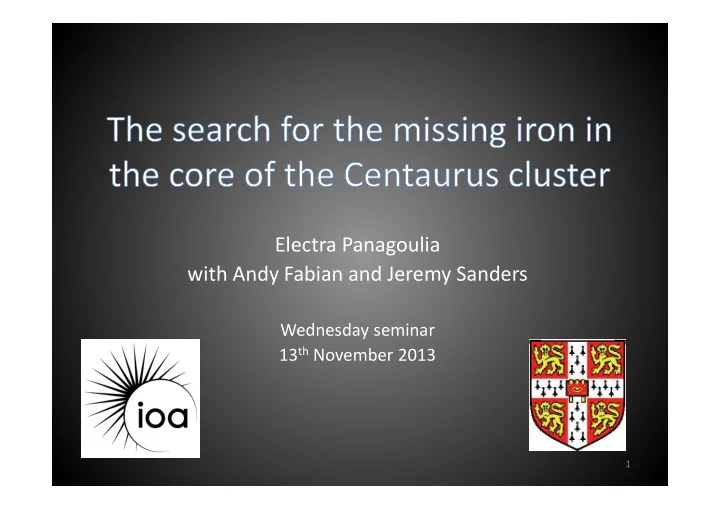

Electra Panagoulia with Andy Fabian and Jeremy Sanders Wednesday seminar 13 th November 2013 1
• Introduction – Why study clusters? – Cooling flows and heating – The Chandra telescope – The Centaurus cluster in X-rays – The Centaurus cluster in optical and IR Data analysis and results • Imaging – Spectra – Where is the missing iron? • Conclusions • Future work • 2
Largest gravitationally bound • objects in the Universe Trace primordial density • fluctuations Ideal for studying large structure • formation and evolution → powerful cosmological probes But: details of processes are not • clearly understood If clusters are to be used as a • reliable testbed for structure formation, internal processes Abell 1689 (space.mit.edu) need to be better understood 3
• X-rays carry the thermal imprint of processes such as AGN feedback and cluster mergers • They provide a window through which we can study the effects of some of the most energetic processes in the Universe on large scale structure formation Hydra A (chandra.harvard.edu) 4
• Based on S x profiles, two types of clusters: cool-core (CC) and non-cool core clusters • For CC clusters, high n e and low T in cores → t cool << cluster age → high star formation rates, lots of cool and cooling gas • But: observed properties do not match theoretical predictions (cooling flow NGC5813 (z=0.0065) problem) 5
• AGN feedback is thought to be main heating mechanism (Birzan+ 2004, Dunn & Fabian 2006, McNamara & Nulsen 2012…) • Outstanding problems: transport mechanisms poorly understood, some star formation, optical filaments… → gas in clusters is mulAphase: A SIMPLE COOLING FLOW FFT-processed and smoothed 0.3-7 keV image of the Perseus cluster MODEL IS INSUFFICIENT (Sanders & Fabian 2007) 6
Cooling flows and AGN heating are primarily manifested in group • and cluster cores Need high spatial resolution to disentangle details of these • processes in innermost regions 7
• 2 nd closest cluster after Virgo (z=0.0114) • Studied extensively at all wavelengths because of brightness and proximity • X-ray: – weak cooling flow (Allen+ 2001) – central cooling time <0.5 Gyr 5 kpc – 2-temperature structure in core + central iron abundance drop (Sanders & Fabian 2006, Multi-band X-ray image of NGC 4696 Sanders+ 2008) (Fabian+2005) 8
Herschel PACS multiband Hα image of NGC 4696 (Crawford+ image (Mittal+ 2011) 2005) 9
200 ks of clean exposure time 0.5 – 7.0 keV composite images of NGC 4696 10
Interested in radial profiles • Created 22 concentric annuli, • each containing ~115000 counts in total (S/N≈340) in the 0.5-7.0 keV band Projection effects: spectra • deprojected using DSDEPROJ (Sanders & Fabian 2007, Russell+ 2008) – like peeling an onion! Joint fits performed in the 0.5- • 7.0 keV band using an absorbed optically thin thermal model (altmd.com) 11
Panagoulia+ 2013 12
• Steep drop in Fe abundance in central 7 kpc, particularly innermost 5 kpc • Si and S show similar abundance profiles, drops possibly have same origins as Fe Panagoulia+ 2013 13
• Bimodal temperature in central 5 kpc (e.g Sanders+ 2008) • Joint fit of two innermost annuli using 2-temperature model • “Missing” iron mass in inner 5 kpc is 1.4 × 10 6 M solar 14
Smoothed multi-band PACS image (left) and SPIRE image (right) (Mittal+ 2011) • Drop in Fe, Si and S abundances is co-spatial with the brightest dust emission seen in the IR with Herschel 15
Need to remove Fe from cluster core, but without removing H too 3. Filaments are dragged outwards 2. Much of the iron by buoyant bubbles can remain in grains, and join the filaments, making them dusty 4. Filaments are somehow destroyed at ~20 kpc, enhancing the local ICM 1. SNe and stellar winds 5. Approximate steady inject Fe in state achieved if 10% of cluster core filaments are dragged out per AGN cycle 16
• Analysed ~200ks combined Chandra observation of NGC4696 • Obtained temperature, Fe, Si and S abundance profiles • Steep drop in Fe abundance in central 5kpc, equivalent to 1.4 x 10 � M solar • Similar drops in Si and S abundances • Part of this missing Fe could be locked up in cold dust, as seen by Spitzer and Herschel • Fe injected by stellar mass loss is in grains, becomes incorporated in the filaments in the same region, which are then dragged outwards and destroyed • Si and S abundance drops could have the same origin 17
• A 500 ks Chandra observation was approved in August 2013 • Will test our theory regarding the depletion of Fe onto dust grains by measuring radial abundances of Ne and Ar • We hope to further study the abundance structure of the Centaurus cluster with ASTRO-H (launch in late 2015) Astro-H (Illustration: Akihiro Ikeshita / JAXA) 18
Si S Fe-L Left: Projected 0.5-7 keV Ar Ca spectrum for the innermost 2.7 kpc (200 ks Chandra) Si XIV S XVI O VIII Si XIII S XV Ar XVII Ca XIX Right: Simulated 0.5-7 keV spectrum for the inner 10.8 kpc, for a 100 ks ASTRO-H Ne X observation Ar XVIII 19
Thank you! Any questions? 20
Recommend
More recommend